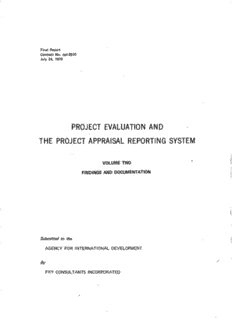Table Of ContentI
. g3~
3
02-
Final Report
Contract No. csd-2510
July 24, 1970
PROJECT EVALUATION AND
THE PROJECT APPRAISAL REPORTING SYSTEM
VOLUME TWO
FINDINGS AND DOCUMENTATION
\4
Submitted to the
AGENCY FOR INTERNATIONAL DEVELOPMENT
By
FRY CONSULTANTS INCORPORATED
"IFYOU DON'T KNOW WHERE YOU'RE GOING,
ANY ROAD WILL GET YOU THERE,"
Final Report
Contract No. csd-2510
July 24, 1970
PROJECT EVALUATION AND
THE PROJECT APPRAISAL REPORTING SYSTEM
VOLUME TWO
FINDINGS AND DOCUMENTATION i
V
Submitted to the
AGENCY FOR INTERNATIONAL DEVELOPMENT
By
FRY CONSULTANTS INCORPORATED
STUDY TEAM:
LEON J. ROSENBERG (DIRECTOR)
LAWRENCE D. POSNER
EDWARD J. HANLEY
VOLUME TWO: FINDINGS AND DOCUMENTATION
CHAPTER 1. INTRODUCTION AND SUMMARY
CHAPTER II. OVERALL SYSTEM CONCEPTS
CHAPTER III. ACTION PLAN
CHAPTER IV. STUDY FINDINGS
CHAPTER V. RESEARCH AND ANALYSIS USING PAR DATA
APPENDICES
I
3
II
PREFACE
I
This final report issubmitted to the Agency for International Development
by Fry Consultants Incorporated, inaccordance with the requirements of
Contract No. A.I.D./csd-2610. This report describes the study methodology,
findings, and recommendations resulting from ayear-long study of the
evaluation of non-capital projects.
The first volume of the report, submitted under separate cover, summarizes
both the study and the recommendations.
I
This, the second volume of the report, presents the detailed findings and
recommendations.
The third and final volume of this report contains an "implementation
package" intended to assist the USAID Missions inimplementing a Mission
useful evaluation process.
I
iii
TABLE OF CONTENTS
PAGE
Is OBJECTIVES, SCOPE, AND METHODOLOGY OF THE STUDY
A. Study Objectives 1-1
B. Study Methodology 1-3
C. Measures of PAR Validity 1-15
D. Assessment of PAR Utility 1-16
E. General Approach to the Mission Surveys 1-17
F. Data Gathering Techniques and Forms 1-18
II. OVERALL SYSTEM CONCEPTS AND REQUIREMENTS
A. Functional Specification for the Improved PAR System 11-3
B. Summary of System Design Requirements 11-16
C. Key to Recommended Improvements: Another
View of AID Technical Assistance Projects 11-17
D. Project Evaluation as a Subsystem of the AID
Project Management and Programming Systems 11-32
E. Operation of the PAR System 11-42
(Continued)
iv
TABLE OF CONTENTS (Continued)
PAGE
III. AN ACTION PLAN FOR
STRENGTHENING AID PROJECT EVALUATION
A, Introduction and Summary III-1
B. The Proposed Action Plan III-4
C. Roles and Responsibilities for Implementing
PAR Improvements 111-27
IV. THESTUDY FINDINGS
A. Introduction, *IV-1
B. The Mission Response: The PAR as the
. Initiator of an Evaluation Process IV-9
C. The PAR as a Report IV-60
D. Some Underlying Issues: The Design and
Management of Technical Assistance Projects IV-86
ANNEX TO CHAPTER IV TABULAR SUMARIES OF FINDINGS
(Continued)
v
TABLE OF CONTENTS (Continued)
PAGE
V, RESEARCH AND ANALYSIS WITH PAR DATA
A. Introduction V-1
B. The Need for Research About Technical Assistance V-2
C. The Fry Research Effort -- What Has Been Done V-6
D. Proposed Research and the Use of PAR Data for
Analysis V-31
ANNEX -- CHAPTER V.
APPENDICES
EXHIBITS
vi
CHAPTER I
OBJECTIVES, SCOPE, AND METHODOLOGY OF THE STUDY
A. STUDY OBJECTIVES
1. General
The object of this study was to improve evaluation of non-capital pro
jects sponsored by the Agency for International Development. Itwas
expected that the primary mechanisms for introducing needed improvements
would be modifications in the Project Appraisal Report (PAR) and the
related aspects of the Project Paper (PROP) and Project Implementation
Plan (PIP). Infact, one of the immediate causes for authorizing the
study was USAID resistance to the newly introduced Project Appraisal
Report. There was some comment that the PAR was difficult to fill out
(consuming too much on-site management time), was of questionable value
to AID/W, and was redundant with existing USAID management practice.
On the basis of preliminary reviews of USAID comments and discussions with
AID/W personnel, the study objectives were refined and presented in a
detailed work plan submitted to the Agency on September 2, 1969. In order
to provide a sharper focus to the study, we defined two principal objec
tives to develop:
* A PAR system that supports effective project evaluation
1-2
Methods of using that system to enhance project analysis and
monitoring.
The PAR system must support as well as report on the project evaluation
process. Itwas considered quite possible that the optimum PAR system
would consist of two elements: one supporting an evaluation process
carried on within the Mission, and the other reporting on that process.
It is important to note that the study emphasis was on the PAR system
rather than the report--on the interrelated set of activities and events
required to initiate and sustain a Mission-useful project evaluation
process, not on what document gets sent to AID/W.
2. Specific Study Outputs
Two types of outputs were required of the study:
(1)Specific, action-oriented recommendations and plans for
implementing an effective PAR system;
(2)Recommendations for improving USAID technical assistance
management by concentrating on critical factors and
tradeoffs relevant to classes of, as well as individual,
projects.
Action plans and procedures for implementing the recommended improvements
are included inthis report to meet the requirements of the'first item.
Recommendations of the second type are addressed for the most part to the
design and management of technical projects rather than to improvements
in content, thus address inobserved deficiencies inmanagement.
Description:.3 g3~ i 02-final report contract no. csd-2510 july 24, 1970. project evaluation and the project appraisal reporting system. volume two findings and documentation

